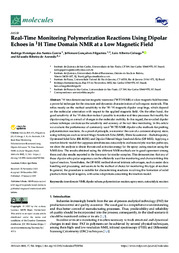Real-Time monitoring polymerization reactions using dipolar echoes in 1H time domain NMR at a low magnetic field.
Real-Time monitoring polymerization reactions using dipolar echoes in 1H time domain NMR at a low magnetic field.
Author(s): GARCIA, R. H. S.; FILGUEIRAS, J. G.; COLNAGO, L. A.; AZEVEDO, E. R.
Summary: 1H time domain nuclear magnetic resonance (1H TD-NMR) at a low magnetic field becomes a powerful technique for the structure and dynamics characterization of soft organic materials. This relies mostly on the method sensitivity to the 1H-1H magnetic dipolar couplings, which depend on the molecular orientation with respect to the applied magnetic field. On the other hand, the good sensitivity of the 1H detection makes it possible to monitor real time processes that modify the dipolar coupling as a result of changes in the molecular mobility. In this regard, the so-called dipolar echoes technique can increase the sensitivity and accuracy of the real-time monitoring. In this article we evaluate the performance of commonly used 1H TD-NMR dipolar echo methods for probing polymerization reactions. As a proof of principle, we monitor the cure of a commercial epoxy resin,using techniques such as mixed-Magic Sandwich Echo (MSE), Rhim Kessemeier—Radiofrequency Optimized Solid Echo (RK-ROSE) and Dipolar Filtered Magic Sandwich Echo (DF-MSE). Applying a reaction kinetic model that supposes simultaneous autocatalytic and noncatalytic reaction pathways,we show the analysis to obtain the rate and activation energy for the epoxy curing reaction using the NMR data. The results obtained using the different NMR methods are in good agreement among them and also results reported in the literature for similar samples. This demonstrates that any of these dipolar echo pulse sequences can be efficiently used for monitoring and characterizing this type of reaction. Nonetheless, the DF-MSE method showed intrinsic advantages, such as easier data handling and processing, and seems to be the method of choice for monitoring this type of reaction.In general, the procedure is suitable for characterizing reactions involving the formation of solidproducts from liquid reagents, with some adaptations concerning the reaction model.
Publication year: 2022
Types of publication: Journal article
Unit: Embrapa Instrumentation
Observation
Some of Embrapa's publications are published as ePub files. To read them, use or download one of the following free software options to your computer or mobile device. Android: Google Play Books; IOS: iBooks; Windows and Linux: Calibre.
Access other publications
Access the Agricultural Research Database (BDPA) to consult Embrapa's full library collection and records.
Visit Embrapa Bookstore to purchase books and other publications sold by Embrapa.

